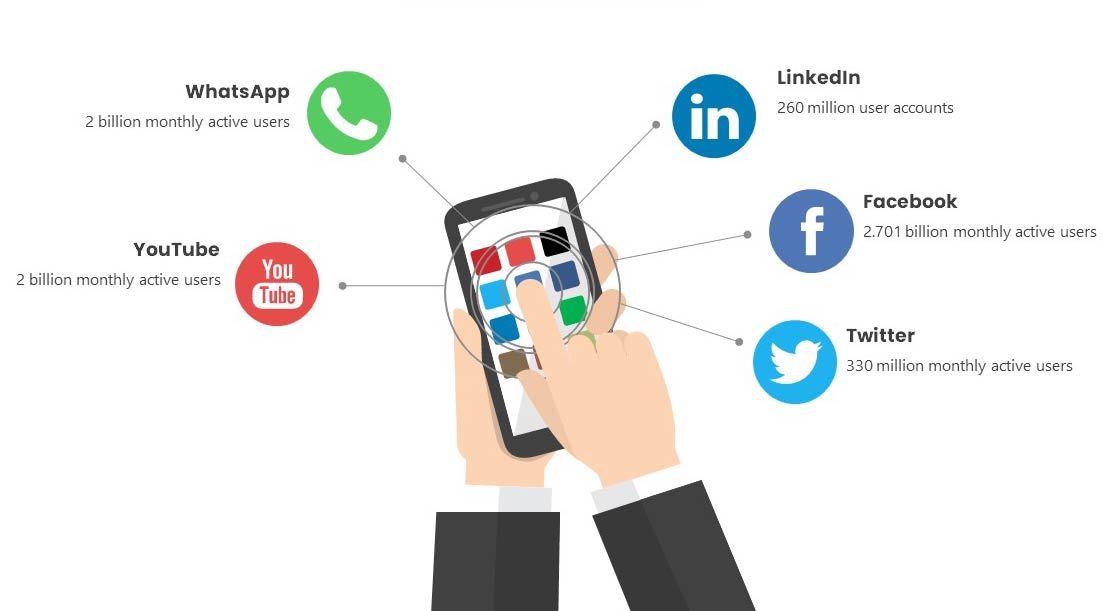Having a social media content strategy in place for your business is essential.
Without a strategy in place, you’ll just end up wasting lots of precious time – floating from one tactic to the next, without accurately measuring results and understanding what works best for your brand.
We’re going to quickly dive into the mechanics of a solid social media content strategy and review the things you need to put in place to make sure your customers are listening to what you have to say.
Choose your social media platforms


From the outset, you need to choose which social media platforms you’re going to use.
Your decisions will rest entirely upon where your audience hangs out.
Don’t make the mistake of choosing a platform that you prefer to use – it’s all about your customers.
If you’ve used Twitter for years and it’s your favourite social media channel, but the majority of your customers spend time on Facebook…guess where you’re setting up shop!
But how do you find out where your customers are?
There are various ways of discovering this. Some of these are:
Customer surveys – send surveys to your email list subscribers or use pop-up survey software on your website, such as Typeform or Qualaroo. Use these surveys to ask your subscribers questions about their preferred social media platforms – you can also ask them about which types of content they prefer to consume, to make the data even richer for your strategy.
Demographics – you’ve probably gathered demographic data on your customers already. You can use this data to profile your customers’ social media platform use. If your audience are aged 18-30 there’s a pretty good chance you’ll find them on Instagram. High-earning corporate-types aged 30-50 might be on LinkedIn. You get the idea.
Competitor research – which social media platforms are your competitors using? Are they receiving much engagement on their posts? Do a competitor audit and put some data together on a Google Sheet. This is a good way of discovering not only what platforms are best to use, but what content formats are the best to publish.
Choose your goals

Now you know where your customers are. But before we go into how best to interact with them, you need to understand your why.
What’s your overarching goal with your social media content?
This is a dynamic assessment that will change over time and may even vary from platform to platform.
You may wish to:
Drive more referral traffic to your website
Increase brand awareness
Generate more leads
The chances are likely that you can answer this question right now, as you read this. Nevertheless, it’s an important question to answer.
Create a content calendar

A social media content calendar will keep you focussed.
Creating and publishing social media content post-to-post – without developing a schedule first – will lead to burn-out, fast. The pressure of dreaming up new content ideas for your business on the fly will keep you on the back foot.
Ideally, you should be planning your content months in advance.
Keyword and topic research takes time, but it’s a worthwhile investment.
If you don’t have the time to do this, you can outsource this research to an SEO expert.
The key is to discover the topics that are interesting your audience and attracting good levels of engagement, then plan to create content that addresses these topics.
Pick realistic creation goals that are achievable with the team at your disposal. If you have big content output goals, could you outsource content creation to a copywriter, or hire a social media manager or turnkey social media service?
This content calendar from Convince & Convert is a useful resource to get you started.
Create social media content
Once you’ve identified which platforms you need to be active on – and what you’re trying to achieve with the content you’re going to produce – you need to get working on your social media content development.
We show you everything you need to know about this right here.
Remember to work mainly with your audience’s favourite formats, but don’t be afraid to experiment and see what sticks. Marketing is all about experimentation.
Create a plan for publishing and promotion
Creating the content is time-consuming and difficult but promoting the content can be equally tough.
You need to publish quality content regularly to get noticed by your audience and the competition for their attention is fierce.
Consider how frequently you’d like to publish, and how you’re going to attract your audience to the content.
Are you going to reach out to influencers, or publications who can amplify your content?
Are you considering paid ads or boosted posts on to increase your reach (particularly on Facebook)?
Cross-post if you’re using multiple social media channels
If you’re creating multiple types of content for different social media channels – ie cross-posting – the logistics can get dizzying in a hurry, so good organisation can save you time and stress.
Social media scheduling tools such as Hootsuite, MeetEdgar etc give you the convenience of managing all your social media accounts in one place. Plug in your content and then schedule its publication at times and dates that you know your audience is most likely to see it.
How do you know?
As with all marketing tactics – experimentation is the key! Post your content at varying times on varying days, and track the data to see what performs well.
Re-purpose content
An alternative to basic cross-posting is to re-purpose your content.
Re-purposing content involves taking original social media content and re-packaging it in a different format so that it has more reach to your total audience.
The source material remains the same, but the method of communication changes.
This excellent Backlinko article explains re-purposing in greater detail and will give you some good ideas.
You should build re-purposing content into your content calendar.
‘Evergreen’ content that isn’t time-sensitive is perfect for re-purposing. You can take a blog post that you published 6 months ago, and turn the content into a YouTube video that feels fresh.
Audit your social media content
So you’re up and running and you’ve been consistently posting quality content on your customers’ preferred social media channels.
How do you review what’s working?
SproutSocial offer a free social media audit template on a Google Sheet that you can download right here.
When analysing your content’s performance, you should follow a 2-step process for deciding your analysis method:
1)Determine your goals for the content (which you should have already done, but you may have multiple goals attributing to multiple pieces of content).
2) Determine the behaviours you desire from your customers that will lead you to your desired goal.
Once you have established these 2 things, you can choose which metrics you’re going to monitor.
Some of the metrics to monitor are:
- Likes
- Comments
- Shares
- Views/impressions
- Clicks
- Sign-ups
- Dwell-time
Which of these metrics would amount to being successful conversions for you?
It’s important to avoid fixating on ‘vanity metrics.’
Vanity metrics are things that look good on paper and give you an ego boost, but don’t really help your business achieve its desired goal.
For example:
If your goal is to drive traffic to your website, you’ll embed links to your site in your social media content, and then track how many of your site visits are coming from the links.
If the visit numbers are low, but your social media posts are getting a crazy number of comments, then your desired goal isn’t being achieved, and the comments are a vanity metric. They look good, but they’re not actually helping you succeed.
Time to implement your strategy
So you’ve read this article, you’ve done your homework and you’ve got a much better idea of what goes into a social media content strategy.
It’s time to start testing that idea by putting a strategy out into the field and see how it performs.
To help you get started, we’ve put together a checklist that will stop you over-thinking things, and nudge you into action!
